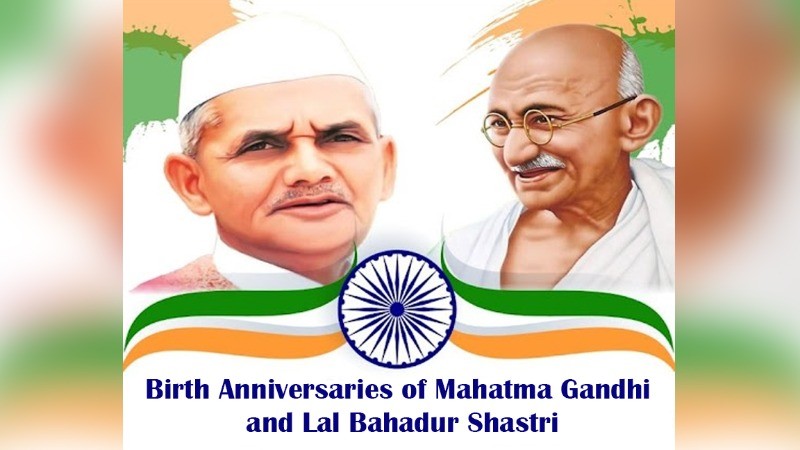
October 2 holds a special place in India's history, as it marks the birth anniversaries of two of the nation’s most revered leaders—Mahatma Gandhi and Lal Bahadur Shastri. Although their paths to leadership and their personal styles were different, both Gandhi and Shastri shared a common vision for India, one rooted in values of simplicity, integrity, and service to the nation.
While Mahatma Gandhi is globally known as the father of India’s independence and the proponent of non-violent resistance, Lal Bahadur Shastri is celebrated for his exemplary leadership during challenging times as India's second Prime Minister. On this day, the country not only remembers their contributions but also reflects on the unique qualities that defined their leadership and how these continue to shape the India of today.
Mahatma Gandhi: The Champion of Non-Violence and Freedom
Mahatma Gandhi, born on October 2, 1869, is synonymous with the Indian struggle for independence. His philosophy of ahimsa (non-violence) and Satyagraha (truth and resistance) inspired millions to resist colonial rule without taking up arms. Gandhi believed that true freedom could only be achieved when it was rooted in justice and morality, not violence. His iconic movements like the Salt March, the Non-Cooperation Movement, and the Quit India Movement became symbols of peaceful resistance against British oppression.
Gandhi’s legacy extends far beyond India’s borders. His teachings influenced global leaders such as Martin Luther King Jr. and Nelson Mandela, who adapted his non-violent approach to their own struggles for civil rights and justice. Even today, Gandhi’s message of peace, tolerance, and social justice continues to resonate across the world, offering a solution to modern-day conflicts.
Lal Bahadur Shastri: The Humble Patriot and Nation Builder
Lal Bahadur Shastri, born on October 2, 1904, rose from humble beginnings to become one of India’s most admired prime ministers. His leadership was defined by simplicity, modesty, and a deep sense of commitment to the welfare of the common people. Shastri is perhaps best remembered for coining the slogan “Jai Jawan, Jai Kisan” (Hail the soldier, Hail the farmer), which highlighted the importance of both defense and agriculture in shaping India's future.
During his tenure as Prime Minister from 1964 to 1966, Shastri led the nation through difficult times, including the Indo-Pak War of 1965 and severe food shortages. His calm demeanor and pragmatic approach won him the trust of the people. Shastri's leadership during the war earned him widespread respect, as he chose to lead with courage and resolve without engaging in unnecessary aggression.
Under Shastri's leadership, India took bold steps toward self-reliance in agriculture, laying the groundwork for the Green Revolution. His policies on rural development and food security continue to influence India’s approach to addressing the needs of its agricultural sector.
Gandhi vs. Shastri: Contrasting Styles, Complementary Visions
Though Mahatma Gandhi and Lal Bahadur Shastri lived during different periods of India’s history, their leadership styles offer insightful contrasts. Gandhi was a global figure, a charismatic leader who mobilized millions with his ideas of non-violence and spiritual resistance. He was a revolutionary thinker, unafraid to challenge the norms of society and governance.
In contrast, Shastri’s leadership was marked by humility and pragmatism. He was less a figure of mass mobilization and more a man of action, quietly working behind the scenes to steer the country through its formative years post-independence. Shastri preferred to lead by example, living a simple life and earning the nickname “the humble prime minister.”
While their approaches differed, both Gandhi and Shastri were deeply committed to serving the nation. They believed in the power of the people, championed rural development, and emphasized the importance of self-reliance. Shastri admired Gandhi and saw in him a mentor whose principles could guide India toward a just and prosperous future.
Their Legacy in Contemporary India
The legacies of Gandhi and Shastri continue to shape India's socio-political landscape. Gandhi’s teachings on non-violence and truth are echoed in India's democratic values and the global peace movements. His ideals of Swaraj (self-rule) and Sarvodaya (welfare for all) still influence India’s policies on social justice, governance, and rural development.
On the other hand, Shastri’s focus on self-reliance in agriculture and national defense remains central to India’s economic and security strategies. His slogan “Jai Jawan, Jai Kisan” continues to inspire the nation, especially in the context of food security and defense preparedness.
October 2 serves as a powerful reminder of the contributions of Mahatma Gandhi and Lal Bahadur Shastri. While their leadership styles and the challenges they faced differed, both Gandhi and Shastri worked toward a common goal—building a free, self-reliant, and just India. Their legacies offer valuable lessons in leadership, service, and integrity that continue to inspire future generations.
As India celebrates the birth anniversaries of these two great leaders, it is a time for reflection on how their timeless values can address the challenges of today. Whether through Gandhi’s path of non-violence or Shastri’s vision of self-reliance, their principles remain guiding lights for India’s journey ahead.